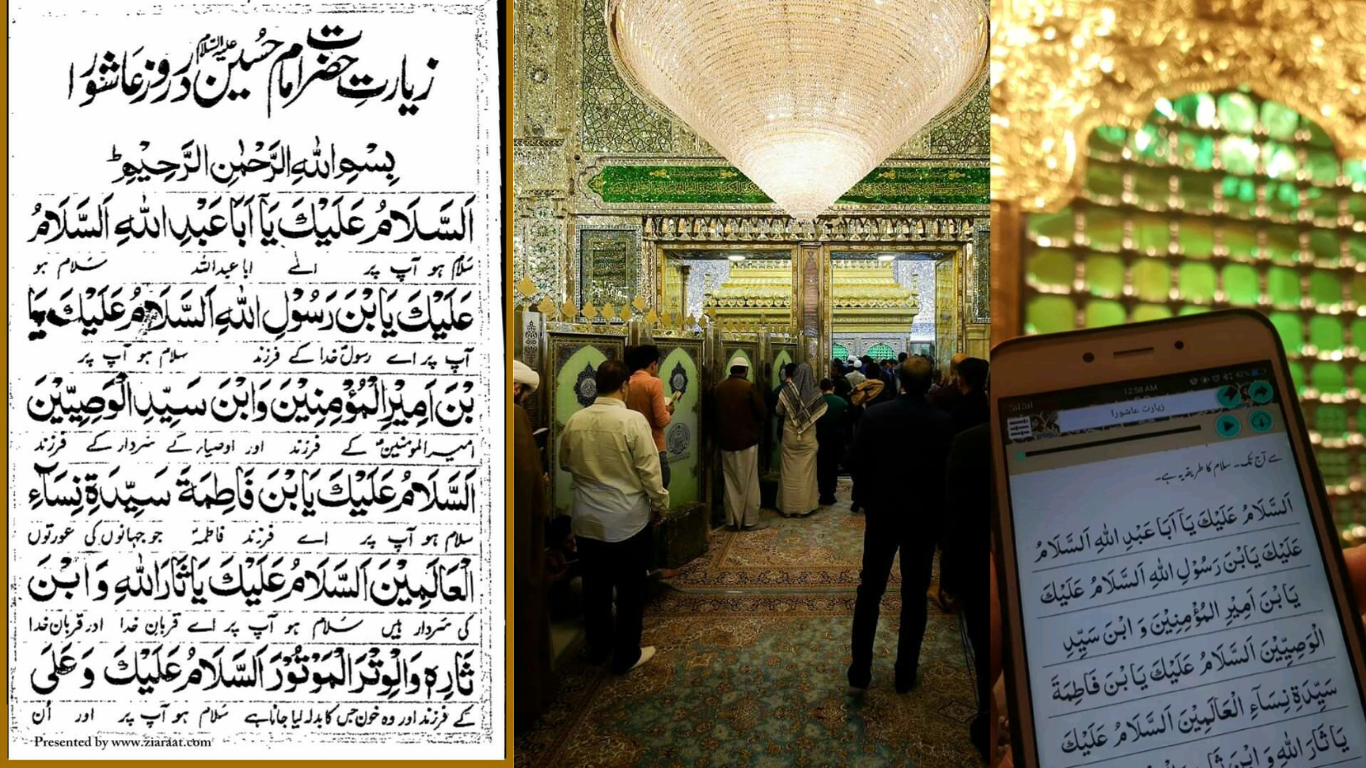

Ziyarat Ashura:
Recitation and Significance Ziyarat Ashura is a significant supplication recited by Shia Muslims, particularly on the day of Ashura, which falls on the 10th of Muharram.
This prayer commemorates the martyrdom of Imam Hussain and
emphasizes themes of loyalty, sacrifice, and the struggle against oppression.
How to Recite Ziyarat Ashura
1. Preparation:
• It is recommended to perform two units of prayer (Rakats) before reciting Ziyarat
Ashura. This act of worship helps to spiritually prepare the individual for the
supplication.
2. Facing Karbala:
• Ideally, the recitation should be done while facing the direction of Karbala, symbolizing a visit to Imam Hussain’s shrine. If physically present at the shrine, this enhances the spiritual experience.
3. Recitation Steps:
• Begin by greeting Imam Hussain with Salam (peace) and then raise your hands in supplication.
• After the initial salutations, recite Ziyarat Ashura, which includes various phrases that express love for Imam Hussain and condemnation of his oppressors.
4. Key Components of Ziyarat Ashura:
• The prayer includes phrases that emphasize the virtues of Imam Hussain and his sacrifices. It also contains expressions of loyalty to his cause and requests for forgiveness and blessings.
• Specific lines are repeated multiple times (often 100 times), reflecting on the significance of Imam Hussain’s martyrdom and its impact on Islamic history.
5. Additional Prayers:
• After completing Ziyarat Ashura, it is customary to recite Dua Alqamah, a supplication attributed to Imam Muhammad al-Baqir that further honors Imam Hussain and seeks
divine mercy.
Ziyarat Ashura is rooted in traditions passed down from the Prophet Muhammad’s family, particularly from Imam Baqir, who emphasized its importance for spiritual elevation. The benefits of reciting this
prayer include:
• Spiritual Protection: It is believed that reciting Ziyarat Ashura provides protection from calamities and misfortunes.
• Increased Reward: Those who recite it are promised immense rewards in the afterlife, including being counted among those who were martyred alongside Imam Hussain.
• Community Bonding: Reciting this prayer collectively fosters a sense of community among
participants, reinforcing shared beliefs and values.
Ziyarat Ashura is not just a ritual; it is a profound expression of faith that connects individuals to their heritage and the sacrifices made by Imam Hussain. By participating in this recitation during Muharram, devotees reaffirm their commitment to justice and moral integrity, drawing inspiration from one of Islam’s most pivotal historical events.
Ziyarat Ashura is distinct from other Ziyarat prayers in several key aspects, particularly in its purpose, structure, and the depth of its spiritual significance. Here are the main differences:
1. Purpose and Focus
• Ziyarat Ashura: This prayer specifically commemorates the martyrdom of Imam Hussain and his companions at the Battle of Karbala. It serves as a profound expression of grief and solidarity with Imam Hussain’s sacrifice, emphasizing themes of justice, resistance against tyranny, and loyalty to the principles of Islam.
• Other Ziyarat Prayers: While other Ziyarat prayers may also honor Imams or significant figures in Islamic history, they often focus on visiting their graves or seeking blessings from them without the same level of emotional intensity associated with the events of Karbala.
2. Structure and Content
• Ziyarat Ashura: This prayer includes specific phrases that are recited multiple times (often 100), such as greetings (Salam) to Imam Hussain and curses (La’an) upon his enemies. The structure is
designed to reinforce the emotional weight of the martyrdom and the commitment to uphold Imam Hussain’s values.
• Other Ziyarat Prayers: Other prayers may not have such a structured repetition or may focus more on general salutations and blessings rather than detailed invocations related to a historical event.
3. Recitation Context
• Ziyarat Ashura: It is traditionally recited on the day of Ashura and during Muharram, making it particularly time-sensitive and linked to specific rituals of mourning. It is often recited in groups during communal gatherings, enhancing its communal aspect.
• Other Ziyarat Prayers: These can be recited at any time throughout the year and may not have the same communal or ritualistic significance tied to specific dates.
4. Spiritual Benefits
• Ziyarat Ashura: Reciting this prayer is believed to offer unique spiritual rewards, including forgiveness of sins, closeness to Imam Hussain, and inclusion among those who were martyred with him. It is often emphasized that regular recitation can lead to profound spiritual benefits.
• Other Ziyarat Prayers: While they also offer spiritual benefits, these may not be as pronounced or specifically linked to historical events as those associated with Ziyarat Ashura.
5. Authenticity and Tradition
• Ziyarat Ashura: It has a strong basis in hadith literature, with authentic narrations tracing its origins back to Imam Muhammad al-Baqir and other Imams. This lends it a significant status within Shia Islam.
• Other Ziyarat Prayers: While many are also rooted in tradition, they may not carry the same level of authenticity or historical weight as Ziyarat Ashura.
In summary, Ziyarat Ashura stands out due to its deep emotional connection to the events of Karbala, its structured format emphasizing specific invocations, its timing during Muharram, and its recognized spiritual benefits. These elements make it a unique aspect of Shia devotional practice compared to other Ziyarat prayers.

A sacred site known for its rich history, spiritual significance, and architectural beauty. A place of devotion and healing, attracting visitors from all over.
© 2025 Husain Tekri. All Rights Reserved.